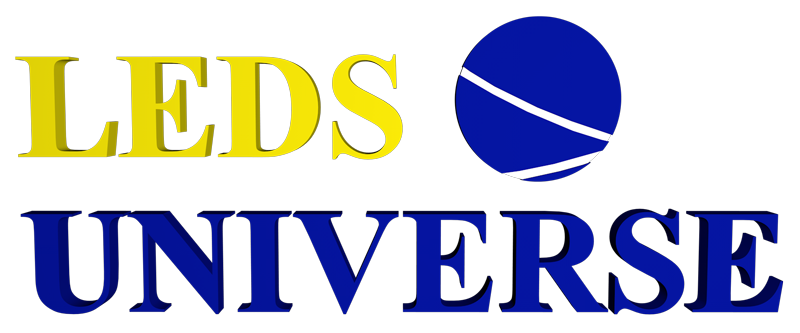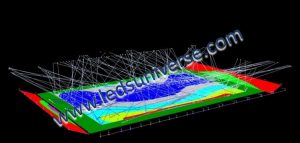 If you have a sports project at hands and you need a company to assist you with an initial projection and estimation about the layout of the lamps around the pitch, feel free to enter in contact with us so we can help you with calculations. Usually, you will need to receive some information on your side, so that our estimation can be as accurate as possible. That info hinges most of the times on the following factors:
If you have a sports project at hands and you need a company to assist you with an initial projection and estimation about the layout of the lamps around the pitch, feel free to enter in contact with us so we can help you with calculations. Usually, you will need to receive some information on your side, so that our estimation can be as accurate as possible. That info hinges most of the times on the following factors:
1. Dimensions of the field
2. Number of Poles
3. Where are poles located (meaning distance to the sidelines)
4. Mast Height
5. Level at which the matches will be played (amateur, semi-professional, professional, or professional with broadcasting TV transmissions – this decides lux)
National and International Lighting Design Standards
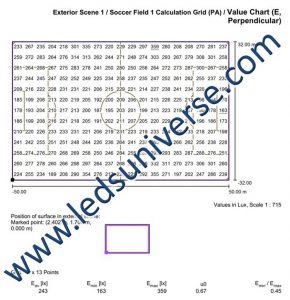 Football lighting is governed under various national and international standards depending on the level of training and play at your football club. English FA and European Football Standards, as well as FIFA and UEFA have varied sets and classes of lighting. Therefore, a number of parameters are at stake when one is investing in football field lights installation. These parameters form the basis for the perfect soccer pitch.
Football lighting is governed under various national and international standards depending on the level of training and play at your football club. English FA and European Football Standards, as well as FIFA and UEFA have varied sets and classes of lighting. Therefore, a number of parameters are at stake when one is investing in football field lights installation. These parameters form the basis for the perfect soccer pitch.
We actually have a very extensive article just on the football field lighting standards & regulations. Please feel free to explore more.
However, there are a number of common mistakes that can be made if end-users just buy sports lamps without first consulting a professional and experienced lighting company, especially at the designing stage.
What are the Basic Parameters for Perfect Soccer Field Lighting Design?
1. Brightness or Lux Level
The lux levels differ completely in both, televised and non-televised tournaments. An international level football field has the highest standard of lux (1200) as compared to school and college pitch (150 lux level). Football field lights installation across a number of stadiums tend to have issue with the right lux level, so discuss with us our project so we can propose exactly what you are expecting.
2. Uniformity Standards
One of the significant parameters is the lighting uniformity that is distributed between a scale from 0 to 1 (max). It is the ratio of minimum illuminance to average illuminance. Lighting uniformity differs with change in lux. The higher the uniformity ratio, the more lux drops. So, in cases of high uniformity, more LED football field lights and lamps will be needed for the overall lighting installation.
3. Color Temperature
4000K – 5500K is the general color temperature required for a standard football field. Even then a number of lighting designs change their color temperatures to improvise on illumination for the players and audiences, alike.
Recreating a Soccer Field Lighting Design
There are five major steps to follow when designing a football pitch:
Step 1: Creating the Football field with the proper size and dimension
Step 2: Plot the pole layout and mast location
Step 3: Implant the Flood lights
Step 4: Adjust the lamps on the Dialux lighting software for balanced distribution (these can take hour or even several days depending on the complexity of the project and ratios required)
Step 5: Generating the photometric analysis report
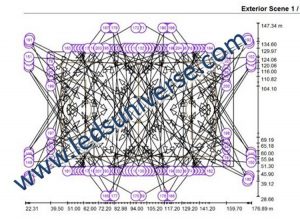 Football field lighting design is an important part of plotting a new project. However, it is just one side of the deal. You also want to make sure the manufacturer from whom you buy the lights, has bright fixtures, with very high-end lens, because the lighting design can just be optimized if the LED lamps, themselves, have good propelling and illuminance ratios (and lower leakage rates).
Football field lighting design is an important part of plotting a new project. However, it is just one side of the deal. You also want to make sure the manufacturer from whom you buy the lights, has bright fixtures, with very high-end lens, because the lighting design can just be optimized if the LED lamps, themselves, have good propelling and illuminance ratios (and lower leakage rates).
As you can understand, the soccer field lighting design is a good and accurate estimator of a project, but it starts off the premise of an IES file, a file which tries to portray, in mathematical terms, the behavior of a specific sports flood light. And, therefore, regardless of the design, the LED light already needs to be pretty powerful and luminous efficient in its ability. This is something out of the Dialux lighting design influence, and strictly up to the to the production standard of the lighting equipment itself.
How Dialux Designs Might Vary
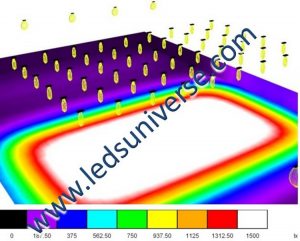 Dialux and soocer lighting designs might take hours and even days of research and development, depending on their complexity, in order to create the perfect lighting component for a football stadium. The lighting differs with varied stadium sizes and usages.
Dialux and soocer lighting designs might take hours and even days of research and development, depending on their complexity, in order to create the perfect lighting component for a football stadium. The lighting differs with varied stadium sizes and usages.
A regular community football pitch may have almost minimal usage of lights whereas a standard tournament field may ask 10x quality of soccer field lighting designs when compared to a community used field. However, with a number of varieties in stadium designs comes a lot of football field lighting design research and we, as individuals, may tend to find it a bit to technical sometimes.
Issues that one can Avoid with Lighting Simulation
Without further ado, let’s look into some of the common mistakes that one can avoid prior to installing these football field lights installation, by firstly plotting a design:
1. Avoiding Light Pollution
With a an average LED lights usage of 25,000w to 80,000 watt, overall power, on most stadiums, chances are that there are light spills that affect the living quality of those residing near the stadium. Therefore, you want to make sure you control this glare.
So, how to fix that? LED Stadium lights come with an anti-glare technology that proffer precise optical system best suited to direct lights to designated areas. The 3rd generation optical lens included in these LED systems and equipments guarantee that light will be focused at where it needs to reach, and not spilling outside of the sidelines.
2. Lifespan of your LEDs
It is best to look at LED lights that have a lifespan of more than 8 years. A lot of investors tend to omit this and end up spending extra on maintenance.
3. Flickering and Dimming
Lights with a rate of flickering higher than 0.4% can tend to create flickers on televised and broadcasted tournament videos. However, opting to use football field lighting design with LEDs that have a flickering rate of 0.3% can help improve the quality of your broadcast.
Quick Recap on the parameters of lighting: 1. Lux Level 2. Lighting Uniformity 3. Color Temperature
By considering the aforementioned factors, your chance of a successful sports field lighting design can greatly improve. You can always seek help from professional football field lighting installation manufacturers and company for the same. If you want our assistance, please drop us a message in our contact form.
